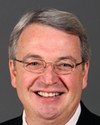Many of us on the board wear different hats. For example, I have a private sector background, so I have a partial hat, I suppose. But specifically on the board now there are about three members with that private sector experience.
I referred this morning to being chair of the governance and nominating committee for the CLS board. This challenge has been a topic of intense thought and debate for us. We have a goal. We've designed our board structure to be from 14 to 18 members, just in line with good governance—not too big, not too small.
Since we have had to pursue and have welcomed multiple partnerships with different provinces, many of our funding arrangements have come with requirements for board seats. So, for example, Alberta has two seats on the board. That's fantastic. B.C. has another member. This is all wonderful, and it's part of building partnerships. Speaking as chair of the governance and nominating committee, though, it creates a challenge in terms of attracting private sector participation. You have only a certain amount of latitude and you try to work through your partners to get the nominations.
That's probably not the main challenge, though. Believe me, I and the entire CLS board would welcome more senior-level engagement. I can tell you more about how we're accessing that senior-level engagement with industry in ways other than through the board, but with respect to the board, the way we've been successful—we talked about the two solitudes between industry and the university—is to continue to have that ambitious industrial target and build the team to pursue those targets, to build the partnerships. Once we've built those partnerships, they're then turned into the board-level relationships.
For example, this morning you've heard about the work we did with AREVA around mine tailings. Now we have the former CEO of AREVA on our board.
It's a lot of hard work, and attracting those senior executives onto the board is really one and the same issue as the industrial research and the relationship between the university and industry. There is a gulf there. We think labs such as the CLS and InterVac/VIDO are closing that gulf. We'll continue to work on it, but it's a tough problem.
As one of the other ways we're trying to engage senior leaders, we're saying that maybe it's easier to get CEOs if you don't try to drag them into the board where they're dealing with budgets and day-to-day things. So we've created a new body.




